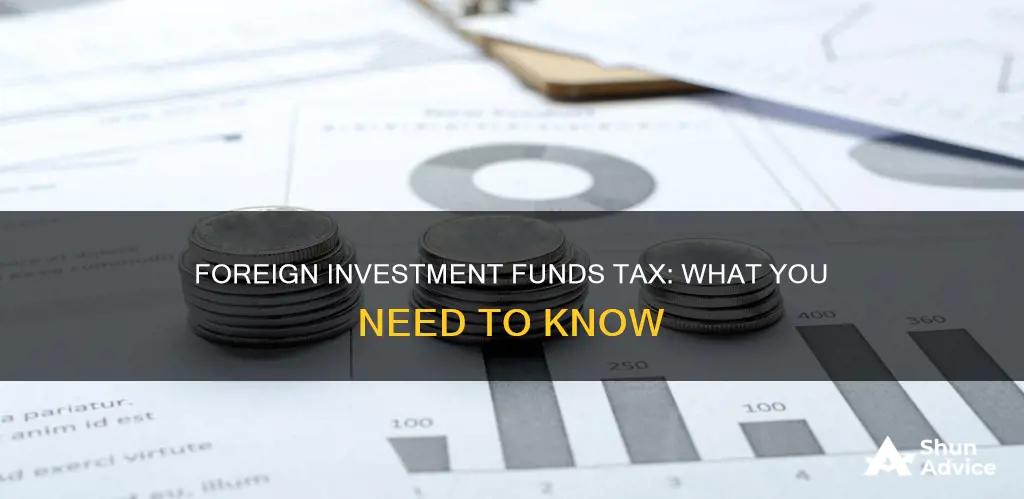
Foreign Investment Funds (FIF) Tax refers to a tariff imposed on residents of a country on asset value gains in foreign holdings. The FIF tax was implemented by the Australian government in 1992 to prevent tax avoidance by residents who held tax-sheltered accounts overseas. However, it was criticised for its complexity and compliance costs and was eventually repealed in 2010. New Zealand also has a FIF tax regime, which taxes interests in foreign investment funds, such as foreign shares, and can result in an annual tax bill based on a percentage of the valuation of that investment.
| Characteristics | Values |
|---|---|
| What is it? | A tariff imposed on Australian residents on asset value gains in foreign holdings |
| Who does it apply to? | Australian residents |
| Who imposes it? | The Australian government |
| When was it implemented? | 1992 |
| When was it repealed? | 2010 |
| Why was it implemented? | To prevent tax avoidance by residents who held tax-sheltered accounts overseas |
| Why was it repealed? | It was criticised for being complicated and costly for taxpayers |
| What is the current situation? | Residents are taxed when they receive distributions from foreign investment funds |
| What are the special considerations? | The Australian government retained specific aspects of the FIF tax to prevent double taxation |
What You'll Learn

Foreign Investment Funds (FIF) Tax in Australia
The FIF tax prevented citizens from deferring the payment of Australian tax on investments made outside of the country. It applied to a range of investments, including personal retirement funds, such as American IRAs and Canadian RRSPs, as well as life insurance wrappers sold by overseas advisors. The FIF tax also applied to any income from foreign companies that were controlled by foreign citizens.
In 2010, the Australian government repealed the FIF tax and replaced it with a more narrow anti-avoidance rule. After the repeal, Australian residents could hold funds in certain types of pensions overseas without paying tax on growth annually. Now, residents are taxed only when they receive distributions from foreign investment funds, at the same rate as the domestic equivalent.
Target Funds or Invest: Which is the Best Retirement Strategy?
You may want to see also

FIF and double taxation
The Foreign Investment Funds (FIF) Tax was a tariff imposed on Australian residents on asset value gains in foreign holdings. The Australian government implemented the FIF tax in 1992 to prevent tax avoidance by residents who held tax-sheltered accounts overseas. However, the FIF tax was also criticized for its complexity and the compliance costs it imposed on taxpayers. Due to these concerns, the FIF tax was repealed in 2010.
Today, Australian residents are taxed when they receive distributions from foreign investment funds. This change was made to ensure that Australian citizens do not experience double taxation, which refers to paying taxes twice on a single source of income. Double taxation can occur in both corporate and personal tax situations and can also happen in international trade when two different countries tax the same income.
New Zealand has also faced challenges with its taxation of interests in foreign investment funds (FIFs), which has created financial barriers for some of its residents. New Zealand's FIF tax settings drive a cash tax obligation even in situations where there is no income generated to fund it. This can be particularly challenging for individuals who are taxed on "deemed income" with no expectation of any cash flow to match.
The United States is one country where the issue of double taxation arises, as it taxes citizens and green card holders on their capital gains, regardless of their tax residence. This issue can also arise when a New Zealand tax resident moves to a new country before disposing of their offshore shares.
To address the challenges posed by double taxation, the Australian government retained specific aspects of the FIF tax while moving other parts of the law to the general Australian tax code. The goal is to close tax loopholes and integrate the taxation system so that income is ultimately taxed at the same rate.
Best HDFC Mutual Funds: Where to Invest Smartly
You may want to see also

FIF exemptions
The Foreign Investment Funds (FIF) Tax was a tariff previously imposed on Australian residents by their government. Until 2010, it was levied on asset value gains from offshore holdings. Though it was aimed at preventing tax avoidance, it was criticized for being costly and complex. The FIF tax was repealed in 2010.
De minimis exemption
If you're an individual investor with attributing interests in FIFs that cost less than NZ$50,000 in total, you do not need to calculate income under the FIF rules.
Exemption for ASX-listed Australian companies
The ASX-listed Australian company exemption applies when you own shares in a company that is included on the official ASX list, is an Australian resident, maintains a franking account, and offers stock that is not stapled.
Foreign superannuation schemes
Since 1 April 2014, interests in foreign superannuation schemes have only been taxed under the FIF rules if they are a 'FIF superannuation interest'. This generally means an interest in a foreign superannuation scheme that you acquired while you were a resident in New Zealand or were treated as a New Zealand tax resident under a double tax agreement.
International Tax Disclosure Exemption ITR30
Under this exemption, residents do not need to disclose an interest of less than 10% in a foreign company if it is not an attributing interest in a FIF or if it falls within the $50,000 de minimis exemption.
It is worth noting that the FIF tax settings can create a significant financial barrier for skilled individuals returning to their home countries or migrating to new ones. For those already in their home country, it can lead them to consider leaving to avoid prohibitive tax bills on paper gains.
A Guide to Investing in Canadian Mutual Funds
You may want to see also

FIF and foreign shares in New Zealand
Foreign Investment Funds (FIF) tax is a tariff imposed on foreign investment funds, which are a type of offshore investment with special tax rules. In New Zealand, the FIF tax regime is designed to prevent taxpayers from using investments in offshore entities to avoid or defer their tax obligations. The rules apply to offshore investments held by New Zealand-resident taxpayers and target overseas companies that do not pay dividends.
The New Zealand Inland Revenue Department (IRD) defines a FIF as:
- A foreign unit trust
- A foreign superannuation scheme (prior to 1 April 2014)
- A FIF superannuation interest (from 1 April 2014)
- An insurer under a life insurance policy (if the policy is not offered or entered into in New Zealand)
The FIF rules impose a tax on the underlying income derived from such investments, both to ensure a fair playing field and to encourage investment in NZ-domesticated companies. The rules were introduced in 2007 and amended in 2014.
There are various methods for calculating FIF income, including the Fair Dividend Rate (FDR) Method, Comparative Value (CV), Cost Method (CM), Deemed Rate of Return (DRR), and Attributable FIF Income Method. Retail investors often choose the FDR method, which ensures a flat tax of 5% is paid on the share portfolio's opening market value each year.
The FIF tax regime in New Zealand has been criticised for creating a financial barrier for highly skilled New Zealanders returning to the country and for new migrants. It stands apart from most other OECD countries in its approach to the taxation of such investments, as it does not consider cash flows such as dividends or proceeds from the sale of shares. This can result in a significant tax burden, even when there is no actual income generated to fund it.
Additionally, the FIF tax settings in New Zealand can lead to double taxation, particularly if a foreign country exercises taxing rights when the investment is realised. For example, the United States taxes its citizens and green card holders on their capital gains, regardless of their tax residence.
Feeder Fund Investment: Understanding the Basics
You may want to see also

Passive Foreign Investment Company (PFIC)
A Passive Foreign Investment Company (PFIC) is a non-US company that meets one of two criteria:
- Income Test: At least 75% of the company's gross income is passive income, i.e. income derived from investments or other sources not related to regular business operations.
- Asset Test: At least 50% of the company's gross assets are held for generating passive income, such as investments that produce income in the form of earned interest, dividends, or capital gains.
PFICs are subject to strict and complex tax guidelines by the US Internal Revenue Service (IRS). US investors who own shares of a PFIC must file IRS Form 8621 and are taxed at a higher rate than long-term capital gains. The PFIC rules were introduced to prevent tax avoidance by US taxpayers who were sheltering their offshore investments from taxation.
PFICs can include foreign-based mutual funds, startups, and investment trusts. US investors who hold shares in these types of companies may be subject to PFIC taxation and are advised to seek guidance from a tax professional.
PFICs are taxed through one of three methods: Excess Distribution, Mark-to-Market (MTM), or Qualified Electing Fund (QEF). The default taxation method is Excess Distribution, where investors are taxed on excess distributions and then on the gain from the sale or disposition of stock holdings. With MTM, the PFIC's yearly increases in value are taxed as ordinary gains, and at the end of the year, the marketable stock is treated as if it had been sold and repurchased at its fair market value on the last business day. QEF is a more challenging method due to documentation requirements, but it allows the PFIC to be taxed on its pro-rata share of undistributed earnings for both ordinary income and long-term capital gain.
Malabar Value Fund: A Guide to Investing Wisely
You may want to see also
Frequently asked questions
The FIF Tax was a tariff imposed on Australian residents on asset value gains in foreign holdings. It was implemented by the Australian government in 1992 to prevent tax avoidance by residents who held tax-sheltered accounts overseas. The FIF tax was repealed in 2010.
Foreign investment funds are a type of offshore investment with special tax rules. FIFs include foreign unit trusts, foreign superannuation schemes, and insurers under foreign life insurance policies.
FIF income is attributed to an investor, which means they may have FIF income before actually receiving any money. There are several methods for calculating FIF income, including the fair dividend rate (FDR) method, comparative value (CV) method, cost method (CM), deemed rate of return (DRR), and attributable FIF income method.
The FIF tax settings can create financial barriers for skilled individuals returning to or migrating to New Zealand. It can also lead to double taxation, particularly for individuals who are taxed by a foreign country on their capital gains.







